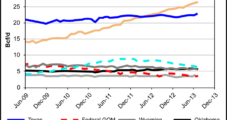Natural gas production in the Energy Information Administration’s (EIA) Other States category, which includes Pennsylvania, Ohio and West Virginia — and, with them, some of the nation’s booming shale plays — reached 26.37 Bcf/d in July, compared with 26.13 Bcf/d in June and 22.67 Bcf/d in July 2012, EIA said Monday.
Category
Articles from Category
Industry Briefs
The Environmental Protection Agency (EPA) is revising the deadline by which owners or operators of facilities subject to the petroleum and natural gas systems source category of the Greenhouse Gas Reporting Rule must submit requests for use of best available monitoring methods (BAMM) to the agency. Specifically, the agency is moving up the prior deadline of Sept. 30 to June 30, according to a final rule published in the Federal Register on Wednesday. The amendment now reads: “For reporting years after 2012, a new request to use best available monitoring methods must be submitted by June 30 of the year prior to the reporting year for which use of [BAMM] is sought.” The EPA said it is not proposing any other changes related to BAMM for oil and gas. Affected facilities would be natural gas pipelines, local distribution companies, oil and gas drilling facilities and natural gas liquids extraction facilities.
Oil and Gas Workers Begin Return to GOM as Isaac Slowly Fades
Weather conditions along the Gulf Coast were gradually improving Thursday as Isaac, which had reached the Louisiana coast as a Category 1 hurricane, weakened and moved into northern Louisiana, but oil and natural gas operators were being cautious about returning to evacuated facilities in the Gulf of Mexico (GOM).
Hurricane Isaac Takes Aim at New Orleans
Isaac, a Category 1 hurricane as of late Tuesday, was expected to make landfall near the mouth of the Mississippi River at about 7 p.m. CDT and then jog slowly through the night toward New Orleans before striking there early Wednesday, the National Hurricane Center (NHC) said.
CFTC Asked to Nix Physical Commodity Options from ‘Swap’ Definition
The Commodity Futures Trading Commission (CFTC) should not lump commodity options that are intended to and can only be settled physically in the same category as “swaps,” said an 11-member coalition of mostly oil and gas producers in a recent plea to the agency.
CFTC Asked to Nix Physical Commodity Options from ‘Swap’ Definition
The Commodity Futures Trading Commission (CFTC) should not lump commodity options that are intended to and can only be settled physically in the same category as “swaps,” said a coalition of mostly oil and gas producers in a recent plea to the agency.
Industry Briefs
Lower 48 gas production in January climbed 0.36 Bcf/d to a record 72.85 Bcf/d mostly on production gains in the “other states” category in the Energy Information Administration’s (EIA) Monthly Natural Gas Gross Production report. EIA said the other states contributed an increase of 0.38 Bcf/d, or 1.8%, partly due to continued drilling activity in the Marcellus Shale and Colorado. New Mexico output rose by 0.10 Bcf/d, or 2.8%. Louisiana posted the greatest production decrease at 0.16 Bcf/d, or minus 1.8%, as some operators reported curtailed production. In Texas production was flat compared with December’s level, which was revised to a 1.2% decline from November. Oklahoma’s January production fell by 0.6% from December. Production in the federal offshore Gulf of Mexico was flat with December. Wyoming was up 0.9%, and Alaska was up 3.4%.
EIA: January Production Gains Mainly from ‘Other’ States
Lower 48 gas production in January climbed half a percent or 0.36 Bcf/d, to a record 72.85 Bcf/d, mainly thanks to production gains in states in the Energy Information Administration’s (EIA) “other states” category.
Marcellus Felt in EIA’s January Production Data
Lower 48 gas production in January climbed half a percent or 0.36 Bcf/d, to a record 72.85 Bcf/d, mainly thanks to production gains in states in the Energy Information Administration’s (EIA) “other states” category, which included drilling activity in the Marcellus Shale.
Chevron CEO: U.S. Shale to Transform ‘Energy Equation’
By 2020 exploration and development across the Marcellus Shale could generate more than $6 billion in federal, state and local tax revenue and employ up to 300,000 people across the region, according to Chevron Corp. CEO John Watson.





